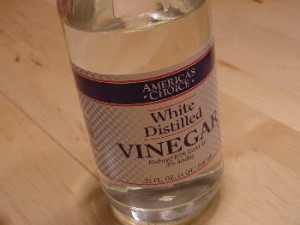Like oil, there are several types of vinegars. There is chemically produced, distilled vinegar, the familiar, extremely inexpensive “white” vinegar. If you want nothing more than a clean, sour flavor, you could do worse than this. But acidity is only part of the reason to use vinegar (or lemon juice): good flavor is the other. I use white vinegar occasionally, but more often for cleaning windows than for cooking.
Wine, cider, rice, malt, and other vinegars may be made by the traditional “Orleans” method – that is, by aging in barrels. Some of these are exceptional, with depth of flavor nearly equaling good balsamic or sherry vinegars, but most vinegars — and almost all reasonably priced ones — are made by more efficient methods. Assuming, however, that they start with good ingredients (for example, wine vinegar should contain no more than wine; Champagne vinegar real Champagne), commercially made vinegar can be quite decent. Good raspberry, tarragon, or other flavored vinegars usually begin with high-quality wine vinegar.
 Balsamic vinegar is probably the most misunderstood food product to have hit the market in the last twenty years. Until then, it was only made in open attics in central Italy, by an arcane method that begins with unfermented grape juice aged for at least fifteen years in a series of increasingly small wooden casks.
Balsamic vinegar is probably the most misunderstood food product to have hit the market in the last twenty years. Until then, it was only made in open attics in central Italy, by an arcane method that begins with unfermented grape juice aged for at least fifteen years in a series of increasingly small wooden casks.
The natural evaporation over that period of time assures an intensely woody, near-unique product. (It’s near-unique because some sherry vinegar, a recent addition to our markets, is made in a similar fashion.) It also assures a very, very expensive product: Truly traditional balsamic vinegar costs at least fifty dollars for a quarter-liter, and usually more. It may be worth it: A few drops can change a dish. But few people keep real balsamic vinegar in their homes, even in Italy.
What we call balsamic vinegar, then, did not exist until marketers realized the appeal of a sweet, oaky vinegar. They came up with a cheap product, usually selling for about four dollars per half-liter, that contains no more than cheap wine vinegar with sweetener and coloring added, and which can be made overnight. Nevertheless, it can be legally labeled “aceto balsamico di Modena” (balsamic vinegar of Modena), just like the expensive stuff. But it is not worth buying.
These days, there are some producers who are making what you might call a “halfway” balsamic vinegar, aging wine must be in wooden barrels for up to three years and selling the product — which can be quite good — for about ten dollars a half-liter. This is not cheap, but if you find a brand that has good, “warm” flavor, stick with it and you will be satisfied.
The alternative is Spanish sherry vinegar, which is essentially a good wine vinegar with a strong flavor of wood. It’s almost always a good substitute for balsamic vinegar.
A Word about Acidity
All vinegar contains acetic acid, which can make up from 4.5 to 9 percent of the total. This means that some vinegars are twice as acidic as others. As long as your vinegar contains at least five percent acid, it can act as a preservative in pickle-making. Other than that, acidity is a matter of taste, but obviously stronger vinegars will require a higher percentage of oil in making vinaigrettes. Vinegar of relatively low acidity, from 4.5 to six percent, will give you all the flavor you need without adding more sourness than you want. (Most rice vinegar is 4.5 percent; most wine and balsamic vinegar is about six percent.)
Freshly squeezed lemon juice and, to some extent, lime juice, can substitute for vinegar in every instance except for preserving. The flavor, of course, will be different.
